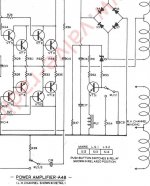Complete amateur with some experience but plenty of enthusiasm.... The last device I worked on was a 1970s solid state hifi amplifier with two 10,000uF capacitors smoothing each channel. On the bench right now, is an early '50s table-top radio which has two 16uF smoothing the mains.
Technology and purpose are different, I know, but the difference seems enormous.
Thanks
Technology and purpose are different, I know, but the difference seems enormous.
- Sugden A48: solid state, 45W, 'hifi' (high bandwidth, low noise, etc.)
- HMV 1121: valve, <5W, 'lofi' (adequate for AM radio)
Thanks
You are comparing apples to oranges 🙂
And ignoring that although Capacitance is the most obvious parameter, what they actually do is store energy , received in brief charging pulses and leisurely released to load as needed.
And said stored energy must be proportionate to amplifier power needs.
Energy is 1/2 C * V^2
* Sugden A48

10000uF is actually coupling capacitor; power supply uses 4700uF, with 71V DC rail voltage
So stored energy is 11.8 Joule
* 50´s tube radio:
Now we have 16uF , loaded to, say, 250V DC = 0.5 Jule
Now let´s weigh that considering power needs
Sugden A48, a Class AB SS amplifier, will have around 60% efficiency (70-75% is ideal amp theoretical maximum) so at rated power it will draw some 75W from supply.
For an apples to apples comparison, let´s calculate "Joule per Watt" on both.
Sugden is 11.8/75=0,157 J/W
50´s radio, rated 5W consumption, is: 0.5/5=0.1 J/W
Suddenly difference does not look HUGE, at all.
Also: in the 50´s capacitors were expensive , tube rectifiers were strictly limited on how much capacitance could they feed (it was even stated in datasheets) with 32uF being an often quoted value, while a 70´s amplifier could use "as much as it wanted".
To boot it was a perceived high quality amplifier, so they would use higher than average values, while a competitive commercial amp , about same ratings, would be happy with just 2200uF main cap, go figure (and a much smaller, say also 2200uF coupling cap), which reduces difference to zero.
As they usually say, "the devil is in the details" 😉
And ignoring that although Capacitance is the most obvious parameter, what they actually do is store energy , received in brief charging pulses and leisurely released to load as needed.
And said stored energy must be proportionate to amplifier power needs.
Energy is 1/2 C * V^2
* Sugden A48
10000uF is actually coupling capacitor; power supply uses 4700uF, with 71V DC rail voltage
So stored energy is 11.8 Joule
* 50´s tube radio:
Now we have 16uF , loaded to, say, 250V DC = 0.5 Jule
Now let´s weigh that considering power needs
Sugden A48, a Class AB SS amplifier, will have around 60% efficiency (70-75% is ideal amp theoretical maximum) so at rated power it will draw some 75W from supply.
For an apples to apples comparison, let´s calculate "Joule per Watt" on both.
Sugden is 11.8/75=0,157 J/W
50´s radio, rated 5W consumption, is: 0.5/5=0.1 J/W
Suddenly difference does not look HUGE, at all.
Also: in the 50´s capacitors were expensive , tube rectifiers were strictly limited on how much capacitance could they feed (it was even stated in datasheets) with 32uF being an often quoted value, while a 70´s amplifier could use "as much as it wanted".
To boot it was a perceived high quality amplifier, so they would use higher than average values, while a competitive commercial amp , about same ratings, would be happy with just 2200uF main cap, go figure (and a much smaller, say also 2200uF coupling cap), which reduces difference to zero.
As they usually say, "the devil is in the details" 😉
Last edited:
JM beat me to it. It's about stored energy and capacitor costs, which he explains well.
It's also about impedance, the tube amp is a much higher impedance load on the power supply than the solid state amp.
It's also about impedance, the tube amp is a much higher impedance load on the power supply than the solid state amp.
Thank you JM. Sorry, but I'm afraid I wasn't precise enough ... My Sugden is an A48-II. It does have 10,000uF capacitors in the power supplies and power rails are 78v. Re-doing the sums, I get a J/W for the Sugden as 0.6 [10000/5*78*78]. Or maybe it's half that voltage since the caps go between centre-tap and end of the PT secondary. Anyway, it's back in the same ballpark, as you point out.



Also: Pano: thanks for reminding me about the differing impedances with the two technologies.
Also: Pano: thanks for reminding me about the differing impedances with the two technologies.
Attachments
In terms of the pole frequency, the tube amplifier could actually win. Assume a 4 ohm loads for the SS amp. 10,000 uF and 4 ohms is a 4 Hz pole frequency. Assume a 5k ohm load for the tube amp. Primary impedance of the OPT here - it will be somewhere in that ballpark. With a 16 uF cap that’s a 2 Hz pole frequency. The tube amp will probably be limited by the OPTs primary inductance, but that’s not the power supply’s fault. The tube amp supply may actually hold up better, having less sag and modulation when driven hard at low frequency.
The ( Joule / Watt ) figure of merit has a dimension of Seconds, if that makes it more clear. Longer is better.
